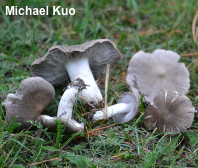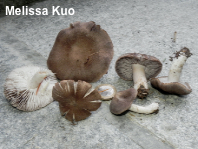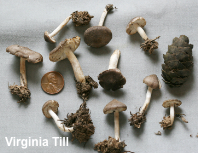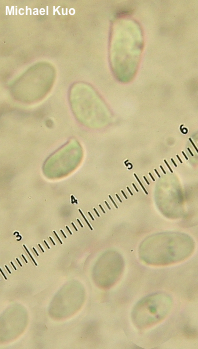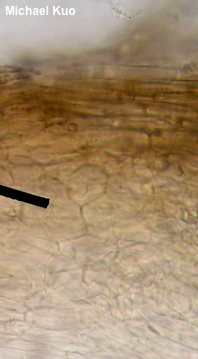| Major Groups > Gilled Mushrooms > Pale-Spored > Tricholoma > Tricholoma terreum |

|
Tricholoma terreum [ Basidiomycota > Agaricales > Tricholomataceae > Tricholoma . . . ] by Michael Kuo Tricholoma terreum can be tentatively recognized by its gray, fibrillose cap, its preference for conifers, and its lack of a distinctive odor or taste. However, there are several species meeting this general description, and microscopic features—including the absence of clamp connections and the presence of a layer of inflated cells beneath the pileipellis—should be confirmed for a more confident identification. The original, European Tricholoma terreum (featured in the top two illustrations) is a broadly defined species that includes several synonyms—notably, from the North American perspective, Tricholoma myomyces, which was separated on the basis of its sometimes-present cortina-like veil. North American treatments generally use the name myomyces to represent a species with a cortina, sometimes opposed to a terreum that does not have a veil. However, European authors have shown that the veil is inconsistent and not correlated to other morphological features. Virtually identical to the naked eye is Tricholoma species 04, which I find under eastern white pine in late fall and early winter, in Illinois. It does not feature a layer of inflated cells beneath the pileipellis, and it is on average a slightly smaller mushroom—but those are the only features I find that are consistently different. I wonder how many "Tricholoma myomyces" collections in North America (and in North American field guides) were identified without microscopic examination, and might be a better match for something else! Tricholoma gausapatum and Tricholoma myomyces (see discussion above) are synonyms. Description: Ecology: Mycorrhizal with conifers—especially with pines, but also with spruce, fir, and Douglas-fir—and more rarely with hardwoods, at least in Europe; growing alone, scattered, or gregariously; spring through fall; Europe and North America. The illustrated and described collections are from Italy, Colorado, and Kentucky. Cap: 4–7.5 cm across; at first convex with a central bump, becoming broadly bell-shaped or broadly convex; dry; finely, radially appressed-fibrillose or, with age, finely scaly; the margin usually finely woolly, especially in young specimens; gray to brownish gray. Gills: Attached to the stem by a notch; close; short-gills frequent; grayish; sometimes protected by a cortina-like veil in very young specimens. Stem: 3–5 cm long; 1–1.5 cm thick; equal; bald; dry; whitish. Flesh: White; unchanging when sliced. Odor and Taste: Not distinctive. Spore Print: White. Microscopic Features: Spores 5–8 x 3.5–4.5 µm; ellipsoid, with a small apiculus; smooth; hyaline in KOH; inamyloid. Lamellar trama parallel. Basidia 4-sterigmate; 30–35 x 5–7 µm; clavate. Cystidia not found. Pileipellis a cutis; elements 6–15 µm wide, smooth, hyaline or brown-walled in KOH. Subpellis clearly differentiated as a layer of inflated cells 10–25 µm across. Clamp connections not found. REFERENCES: (Schaeffer, 1774) P. Kummer, 1871. (Note: N. American references listed here may occur as "myomyces." Kauffman, 1918; Ovrebo, 1973; Ovrebo, 1980; Phillips, 1981; Arora, 1986; Breitenbach & Kränzlin, 1991; Phillips, 1991/2005; Shanks, 1994; Barron, 1999; Noordeloos & Christensen, 1999; Roody, 2003; Kibby, 2006; McNeil, 2006; Nonis, 2007; Buczacki et al., 2012; Bessette et al., 2013; Christensen & Heilmann-Clausen, 2013; Desjardin, Wood & Stevens, 2015; Siegel & Schwarz, 2016; Baroni, 2017; Heilmann-Clausen et al., 2017; Christensen & Heilmann-Clausen, 2018.) Herb. Kuo 10150403, 08281102, 10141404. This site contains no information about the edibility or toxicity of mushrooms. |
© MushroomExpert.Com |
|
Cite this page as: Kuo, M. (2019, November). Tricholoma terreum. Retrieved from the MushroomExpert.Com Web site: http://www.mushroomexpert.com/tricholoma_terreum.html |
